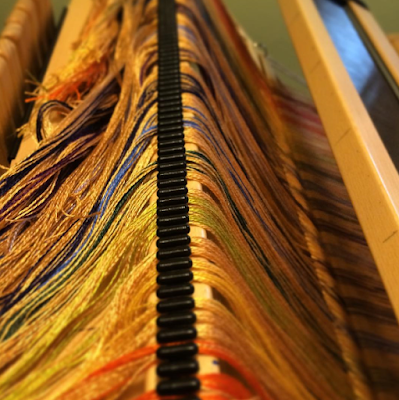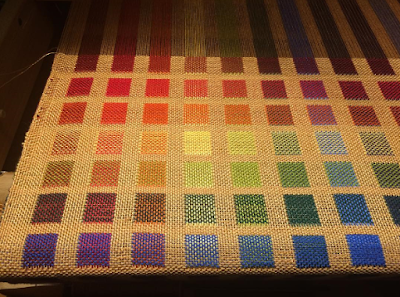A woman at my office is having a baby shortly, and in what was perhaps an excess of enthusiasm I decided to weave her a cotton baby blanket in that lovely Swedish cotton yarn. In doubleweave. Double width. Because who doesn't love challenges. And deadlines.
The result? A triumph of determination and a testament to my ability to weave all night for three nights straight. But it got done in time, which is what counts.
The pattern was a straight twill in a selection of rainbow colours with bleached white cotton as the weft. I set up the loom with 968 ends across 20" on the Louet Jane table loom, with 4 ends in each dent in the reed for 48 epi. The piece was worked in doubleweave with one end open and the other joined for a fold that created a finished piece that was about double the width on the loom.
 |
| Detail showing the open end and the two layers of cloth |
With draw-in, the nominal 40" working width came down to about 37.5" off the loom, and about 50" long (before hemming). After washing and finishing the completed blanket measured 34" x 40".
Working doubleweave was much more straightforward than I expected, and I was helped both by Jennifer Moore's excellent book
Doubleweave, as well as assistance from the Nerd who had far more experience working doubleweave than I.
Among the Nerd's more useful advice was a recommendation to work a single row in a contrasting colour every two inches or so, raising a single bottom layer shaft so that the two layers are joined together. This keeps the two layers roughly together and avoids issues from one layer being higher than the other as the fabric is wound onto the cloth beam, so that both layers are beaten evenly.
 |
| Work in progress showing "joining" picks to keep the layers together |
I worked in a straight twill, throwing two picks on the top layer, and two picks on the bottom layer, for 8 pattern rows, repeated.
I found it was quite easy to avoid weaving errors (or as I call them, "trademarks") on the visible top layer, but almost impossible on the bottom layer, even with tipping the loom up periodically. The Nerd tells me that a mirror helps to spot problems, and I will definitely try that approach on my next doubleweave project.
The other major thing I noted is that the ends tended to get compressed along the fold, in a somewhat irregular way, creating a pattern not unlike snakeskin along the fold line. Not any weaving problems really, just an irregular look. I am told that adding some thicker "support" ends along the final 4 ends before the fold may help avoid this collapse, and I will definitely try this. I think avoiding a high-contrast colour that shows the compression is another trick - - I suspect the irregularities would be much harder to see on a plain white-on-white twill, rather than a white on dark purple, where the compression is more obvious.

After the desired length was woven, I cut the work off the loom and pulled out the securing threads, and then carefully separated the layers to check for any missed picks that caught the layers together. In a stunning triumph, I had no joined areas, and the entire blanket separated easily once I removed the work from the loom and teased apart the ends that had been tied around the apron rod by the cloth beam.
 |
| Carefully separating the layers to check for adhesions |
Finishing was straightforward. I machine-sewed a zigzag stitch along each end to hold the hem during washing, and then threw the piece into the washer and dryer. All that was then required was to trim the loose ends and finish the piece with proper hems.
 |
| Finished blanket, folded in half |
 |
| Finished blanket, unfolded |





















































